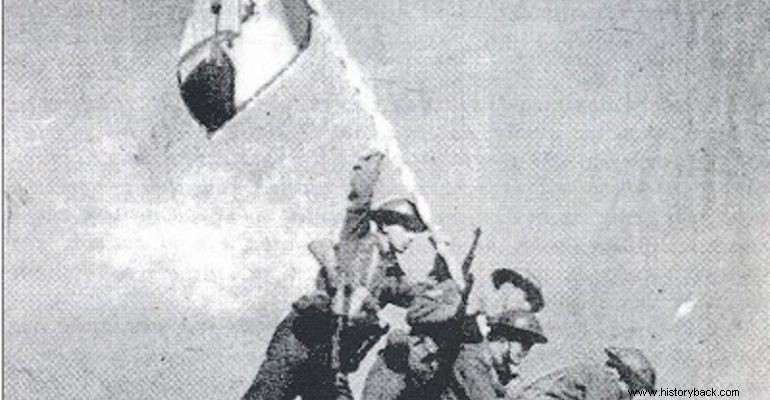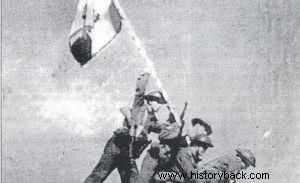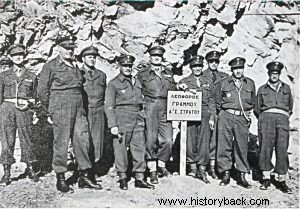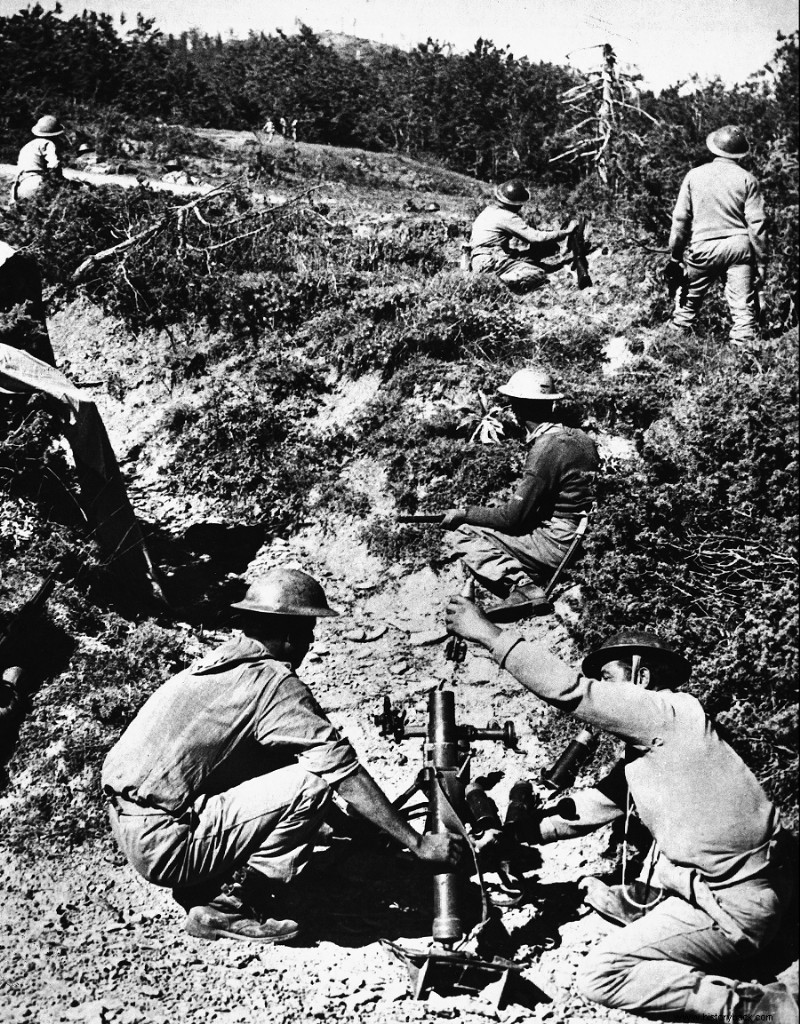
The Battle of Grammos is the last and decisive major battle of the Civil War. It was the biggest defeat of the already doomed Democratic Army of Greece (DSE). Especially after the defeat in the better fortified and organized location of Vichy, the combatants should have little hope for the possibility of repelling the attack against them, let alone of reversing the strategic situation in their favor.
With the operation against Vitsi, the victorious Hellenic Army (HE) sought the occupation of the mountainous complex of Grammos, the last refuge of the DSE, and the destruction of the rebel forces of the defenders there. The operation was the last phase of the Pyrsos plan and the First SS was responsible for its conduct.
Opposing Forces and Plans
The battle of Grammos had a completely different perspective for the two opponents. For ES, it would constitute the final effort, the final foray that would then bring peace. For DSE it was the last chance to stay alive, to hang on to Greek soil, waiting for a new opportunity.
The 1st Army Corps (SS) after the successful deception operation in Grammos between August 2 and 10, 1949, had properly prepared for the final battle. It was logical for Papagos to entrust this crucial operation to his most experienced and popular general, Thrasyvoulos Tsakalotos. After the relatively easy destruction of the "Vitsi fortress" the 1st SS was able to be reinforced with forces from the Vitsi region.
Indeed it did, and the SS was reinforced by the less battle-worn IX Division at Vichy, the 77th Brigade, and by the indefatigable III Commando Division. The SS also had I Division, VIII Division and XV Division, as well as the 8th (minus battalion) 15th, 24th and 40th Light Infantry Regiments (LIP) and the 31st Light Infantry Battalion (LTB).
In terms of artillery, the SS was reinforced with the 101st, 102nd, 104th, 105th and 107th Field Artillery Regiments, the 151st, 152nd and 153rd Medium Artillery Squadrons, the 141st, 142nd, 143rd, 144th and 145th Mountain Artillery Squadrons and anti-artillery elements. Also available were the IX Reconnaissance Regiment, a company of the II Reconnaissance Regiment and the II Tank Company.
Contrary to what, even today, historians and writers close to the left write, ES did not even throw 200 tanks and armored vehicles into the battles of Vichi and Grammos, because it simply did not have that many, nor was its superiority in artillery so great that ensures him the superiority of fire against an opponent who was fighting from organized positions in extremely favorable terrain for defense.
Of course, the forces of the ES were clearly many times greater than the forces of the DSE. But DSE should have thought about this when it first took up arms, and not in 1949, when its last hours were ticking on the clock of its history. Air supremacy was also a given, but the Air Force in this difficult struggle had completely unsuitable aircraft for the role of supporting the ground forces it was asked to play. The Spitfires were not close support aircraft, although the Greek Ikaros did their best to adapt them to that role as well. Only the arrival of the Helldivers changed the situation, dramatically.
On the other hand, DSE deployed all available forces in Grammos. Initially, three divisions were allocated, the 1st of Captain Iotis (Ch. Florakis) with only 540 fighters, which however slipped into southern Greece, with the mission of carrying out counter-distractions and did not take part in the battle, the 8th division of Fokas with 1700 fighters and the The 9th division of Paleologos with 3,350 fighters, of whom several, especially in the 107th brigade, were members of the NOF and also had several women.
After Vichy about 2,200 fighters were channeled through Albanian territory from Vichy to Grammos and took part in the final battle. These fighters were attached to the 103rd, 14th, 102nd and 105th brigades and the officer school brigade which had actual company line strength. However, the DSE received significant support across the border, from the Albanian Army, which although did not cross the border - except in very few cases - but certainly helped its defenders with effective artillery and heavy infantry fire. DSE.
The DSE's plan was simple and provided for on-site defense in its organized positions on the Grammos mountain complex, without any idea of retreat, since this was its last stronghold. That is why the leadership of the DSE, political (Zachariadis) and military (Gousias) constantly issued orders urging its fighters to fanatical resistance.
"The enemy is gathering at Grammos for a decisive confrontation. In Grammos we have all the possibilities to deal a mortal blow to the enemy. We have more sufficient forces and means. More advantageous ground.
"Monarcho-fascism failed in Grammos last year. In Grammos this year we managed a serious blow to him with the maneuver of April. In Grammos from the 2nd to the 8th of August he broke his face. we also have the experience of Vichy and the severe bloodshed we inflicted on the enemy at Vichy.
“Our serious forces in Epirus and in central Greece went into serious offensive actions. Despite the triumphalism, monarcho-fascism is going through a deep economic, political and military crisis.
“Here we can and must bury monarcho-fascism. Our fighters and executives must have unwavering faith and fighting enthusiasm, we must face and crush the enemy. A merciless blow to some panicked people, who because we lost Vichy think we lost the victory.
“We have difficulties, but we will overcome them. The communists must first raise the banner of the struggle against some panicked people, become agents of competitive enthusiasm, indomitable will, unshakable belief in victory.
“When the communists do their duty, around them they will unite as one man with one thought, with one decision, all the fighters and fighters of our army. our slogan remains:Grammos will become the tomb of monarcho-fascism. All in the chariots. Everything for the victory", 20/8/1949, the Political Bureau.
In this way, by lying about attacks on the rest of Greece and beating up the "panicked few", Zachariadis believed he could restore the shattered morale of his army. Especially the morale of the fighters who returned from Vichy was very low. But the rest, with the exception of the very fanatics, could not understand how they would face an opponent far superior in means, numbers, quality and now morale.
The head of the 1st SS, Lt. General Thrasyvoulos Tsakalotos, for his part, had carefully drawn up his plan, knowing that it was now impossible to achieve strategic surprise, since only in Grammos was the DSE and only there could it be hit.
Nevertheless, by ordering the Artillery, from 20 August, to carry out preparations in the southern part of the front, he managed to achieve tactical surprise, making the enemy believe that the main attack would take place in this sector. So he decided to attack in three phases.
In the first, he would seek the liberation of northern Grammos up to peak 2520 and the hills of Skirtsi, Kiafa, Ano and Kato Arena, with simultaneous harassment of the DSE in southern Grammos and prohibition of the escape of the forces of the DSE from the valley of Sarantaporos and the Zuzuliotikos river and Eptachori.
In a second phase, with the northern Grammos secured, the aim would be to clear the southern part of the mountain complex and in the final phase to secure the entire national territory and "seal" the border with Albania.
Tsakalotos, a devotee of maneuver and speed, adapted his plans to these data. So he planned to make a deep penetration of the enemy's formation, on the night of August 25, the date of the start of the attack.
The units of the IX and XV Divisions would carry out the night infiltration in the sector Pyrgos – Tria Synora, Tsoumia – Kiafa – hill 1425 – Kontra Polinga – Kalivia Katsara – Giannochori – Psoriarica. The aim of the night attack was to capture the key points of Ano Arena, Tsoumia, Contra Polinga, Monopylo, hill 1463, Slimnitsa Psoriarika by the dawn of August 25.
Following the continuation of the effort, on August 25th to Mavri Petra - Kiafa - Kalyvia Katsara. At the same time, in the area of Tsarnos - Papoulis - Otoritse, an attack was made at first light on August 25, with the aim of occupying these heights and the final objective was the occupation of the highest peak of Grammos (altitude 2520).
Based on this plan, the XV Division, with the area of responsibility for the area of the upper valley of the Sarandaporos River (central sector), would set out, at 21.00 on August 25, towards Tria Synora - Ano Arena, covering the left of the forces that would operate towards Kiafa .
Then it would continue its movement towards Souflika with the aim of capturing it and it would continue towards Prophet Ilias, Prioni, the neck of Sgouros with the final aim of occupying and if possible encircling the enemy resistances on the Antrapakos hill. This Division had the most unpleasant role, since they would attack the most difficult and best organized sector of the enemy defense, without Artillery or Air support, before August 26.
The 10th Division at the same time would march towards Contra Polinga, Kalyvia Katsara, Psoriarica (northern sector). Its goal was the capture of Kontra Palanga, on the Greek-Albanian border, with the aim of cutting off the escape route of the DSE forces.
Further south, between the XV and IX Divisions, the I Division would operate, with the aim of conquering the terrible Charno. On the same axis, in the second year, the III Commando Division would also act, with the aim of surpassing, over time, the I Division and continuing the attack towards Papouli with the aim of crossing Ano Aliakmons and occupying the hill. Flambouro and finally of H. Squirt, deep in the enemy location.
The VIII Division would initially maintain a defensive posture from Kamenik on the Greek-Albanian border, to the middle valley of Sarandaporos. The 77th Brigade would also maintain a defensive position, blocking the direction of the Zuzuliotikos river - Eptachori. A brigade of the 1st Division would be kept as a SS reserve in the Ammudas - Alevitsa area.
Night Raid
On the evening of August 25, according to the plan, the attack began. The 42nd and 43rd Brigades rushed into the IX Division sector (northern sector). The attack took the defenders by surprise, but they gradually rallied and put up a strong resistance, but not so strong as to prevent contact with the Kontra Poliaga – Psoriarica defensive location.
At first light the divisions were supported by Artillery and Air Force and so at 05.40 Kontra Poliaga (42nd Brigade) fell and at 09.50 Psoriarica (43rd Brigade) fell. The 42nd Brigade continued its rapid advance along the border, occupying Kalivia Katsara, despite heavy Albanian fire against the Greek soldiers.
In the I Division sector the attack also developed according to plan. During the night the 52nd Brigade advanced in depth, cutting through enemy minefields and barbed wire with Bangalore torpedoes. At first light the attack continued and by 12.15 the formidable Charno had fallen, after a fierce fight by the 52nd Brigade. The 595th Infantry Battalion (IP) had the honor of completing the capture of Charno and establishing itself there.
This success was also the harbinger of the definitive victory, since Charnos was really the key to the northern Grammos. The support of the Air Force was important in this success, since the Helldiver vertical attack bombers, which were used for the first time, literally changed the landscape in Charnos. In the same sector the Commandos advanced to Charnos, ready to begin the pursuit of the defeated.
In the sector of the XV Division the units also rushed according to the plan and after overturning minor resistances, bypassing others, by 03.00 in the morning they were in close contact with the main enemy defensive position. The 45th Brigade was forced to halt in the face of strong enemy reaction. The 61st Brigade, however, penetrated the enemy location, but was forced to halt, bearing the brunt of concentrated enemy counterattacks.
The attack of the 73rd Brigade, which occupied Karya, but stopped before Goritsa, developed similarly. Tsakalotos, seeing the attack failing in this sector, decided to stop it and even ordered the 61st Brigade of the XV Division to reinforce the IX whose offensive was developing with brilliant results.
The 77th Brigade attacked on a limited front and managed, after a hard fight, to capture the village of Chrysi, pinning DSE forces. The VIII Division also attacked with the 75th Brigade towards Kamenik, reaching within 50 m of the crest. The 74th and 75th Brigades also attacked and overthrew the enemy's first line of support.
The next day the attack continued. The IX Division, throwing its reserve 41st Brigade into the battle, continued the attack and captured Kalivia Katsara. The 1st Division, in cooperation with the Commandos, also occupied the Papouli hill. The XV Division simply engaged the enemy, as did the VIII Division, pinning important DSE forces. After all, Tsakalotos had already decided to throw his weight in the northern sector, taking advantage of the initial success of the IX Division.
So the next day the IX Division continued its movement towards Porta Osman, moving essentially to the south of the enemy location, between Albanians and units of the DSE. This maneuver paid off and the DSE relaxed its defensive effort on the central and southern front, trying to hold its collapsing northern wing.
But he succeeded very little since on August 28, the IX Division occupied the top of Grammos and continued to move in the rear of the DSE forces, threatening all of them with encirclement, while the I Division and the III Commandos broke through the enemy defense in the central sector .
At 12:20 on August 28, the commandos had also taken over Skirtsi, cutting the communist structure in two. After this development, the sad remnants of the DSE began to withdraw to Albania, so as not to be encircled. On August 30, Kamenik fell without a fight. It was the last hit. The war was over.
The losses of the Hellenic Army (HS) were light and amounted to 243 dead (15 officers) and 1452 wounded and 11 missing. Therefore, the ES did not suffer the overwhelming losses reported by modern historians, with a specific perspective. On the other hand, the dead reached 922 and the prisoners approximately 950.
The rest, around 5,000, fled to Albania. The spoils of the ES were also rich. In total, 17 mountaineers, 15 anti-aircraft and 8 anti-tank guns were captured, in the totality of the remaining DSE artillery, 670 machine guns and machine guns, 57 automatics, 2,598 rifles, 221 mortars – 10 of 120 mm and the rest of 81, 60 and 50 mm .– 4 portable PIAT anti-tank launchers and tons of ammo.
Results
The battle at Grammos ended with another ES victory, although this time the DSE was waiting for the attack. The insurgents after Vichy expected the continuation of the operations against Grammos and therefore it was impossible to achieve strategic surprise.
However, tactical surprise was achieved, which consisted in concealing the direction of the main effort and the time of attack (day and time of attack). In fact, through the deceptive actions of the Artillery from August 20-24, by which the enemy's locations in southern Grammo were attacked (Buhets, Zerma, etc.), the tactical surprise was achieved, especially regarding the manifestation of the hyperkerotic maneuver along the border from the IX Division.
The supercanonical maneuver along the border was qualified due to the small strength of enemy organizations in this sector, the existence of suitable routes of movement on the border, due to the inability of enemy artillery and mortars to launch barrages of fire, due to their command position with a basic orientation on coverage of Tsarnos – Papoulis – Arenas, the importance it would have for the opponent, since it cut him off from his only escape route to Albania. Μοναδικό μειονέκτημα της κίνησης κατά μήκος των συνόρων ήταν ακριβώς η εγγύτητα με τα σύνορα που επέτρεπε στους Αλβανούς να πλήττουν τα ελληνικά τμήματα.
Επίσης πρέπει να δοθούν τα εύσημα στην ΙΧ Μεραρχία η οποία με την παράτολμη, σε βάθος διείσδυσή της, στο βάθος της εχθρικής τοποθεσίας, αδιαφορώντας για την ασφάλεια των πλευρών της, ουσιαστικά κέρδισε τη νίκη.

Στρατιώτες του Ελληνικού και όχι, όπως κακώς λέγεται, κυβερνητικού στρατού, υψώνουν τη Γαλανόλευκη στην κορυφή του Γράμμου.

Στις τάξεις του ΔΣΕ πολέμησαν και αυτονομιστές ΝΟΦίτες.

O στρατηγός Τσακακαλώτος με αξιωματικούς του Α’ ΣΣ.

